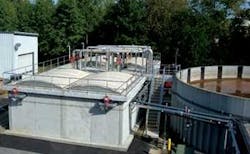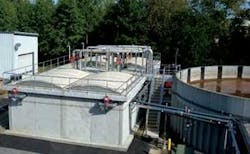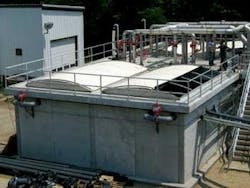By Jim McMahon
Although all food processors have to deal with wastewater generated in their operations, the characteristics of the effluent exiting their facilities can vary greatly, requiring different processing technologies for the most efficient handling of the wastewater. Ken's Foods of Marlborough, MA, a large-volume food manufacturer of salad dressings and marinades, recently upgraded one of its three wastewater treatment facilities to more efficiently process its high-strength organic content wastewater, which contain a high content of fat, oil and grease (FOG) and present serious challenges for waste treatment.
The solution incorporated a unique treatment process called ADI-AnMBR (anaerobic membrane bioreactor), a relatively new form or anaerobic treatment technology developed by ADI Systems, Inc. (ADI) in cooperation with Kubota Corporation of Japan, that uses submerged membranes for biomass retention and solids-liquid separation. The system maximizes biogas production, increases solids digestion and provides a means to easily handle wastewaters with high concentrations of organic matter. The treatment plant is the largest of its kind in the world. It is producing effluent that is virtually free of suspended solids and with a level of chemical oxygen demand (COD) removal of 99.4 percent, allowing its 100,000 gallons per day of wastewater to easily discharge into the municipal system. Considering the high-strength levels of organic content (COD, BOD – biochemical oxygen demand, and FOG) in the wastewater, this performance is exceptional by any industry standards.
As part of the system upgrade, the company's previously installed low-rate anaerobic reactor, also developed by ADI (an ADI-BVF® system), was retained to operate as the reactor portion of the new AnMBR. As a byproduct, the combined system is producing 200,000 to 300,000 cubic feet of biogas per day, which is being captured to provide not only 100 percent of the wastewater treatment plant's heating requirements, but enough residual biogas to power more than 50 percent of the company's manufacturing facility.
Overloading of Original Wastewater System
When the Marlborough facility was originally built, limited space was available to construct the wastewater plant, and Ken's expected that at some point it would need to be expanded to deal with increased wastewater from manufacturing. The company's wastewater originates from wash-down of cleaning mixers, filling machines and other process equipment (no sanitary sewage is processed in this system). It is then pumped into an equalization tank to begin the treatment process.
After equalization, the wastewater was sent to the low-rate anaerobic reactor which was capable of treating waste streams of moderate to very high organic strength. This was followed by a second stage of treatment, a sequencing batch aerobic reactor (SBR), previously designed by ADI, that was needed to polish the anaerobic effluent. These two stages of treatment consistently achieved overall COD, FOG and total suspended solids (TSS) removals in the 98 to 99 percent range.
The treatment plant was designed for a maximum weekly flow of 550,000 gallons with a maximum daily flow of 100,000 gpd. Due to production increases, daily and weekly flows exceeded these design values. One of the issues caused by higher-than-design flows was excessive solids loading from the BVF reactor to the SBR.
“We had too many solids coming from our anaerobic digester,” said Dale Mills, Treatment Plant Chief Operator for Ken's Marlborough plant. “We were spending a lot of time watching the SBR decant to the city and stopping it when the water quality was not good enough. Normally, this would be on a timed cycle, but we had to physically intervene because we had too much solids.”
The City of Marlborough allows the release of 100,000 gallons of effluent per day and limits the concentration of suspended solids effluent to 600 mg/l. The manufacturing plant's production became inhibited by the overall treatment plant.
Ken's brought in ADI Systems to engineer a solution to the problem.
“We had recently completed a very successful site research project on a large-scale anaerobic membrane bioreactor (MBR),” said Dwain Wilson, Director of Process Operations for ADI Systems. “We believed the Ken's Foods application would be perfect for an anaerobic MBR, so we proceeded with the project.”
“The SBR aerobic system was never the bottleneck, it was the anaerobic reactor,” Wilson said. “The solution was to increase the capacity of the anaerobic reactor.”
Keeping the Low-Rate Anaerobic Reactor
From a design perspective, Ken's low-rate anaerobic system is the workhorse of the system, removing in excess of 90 percent of the organic material from the wastewater, as engineered. This system was designed specifically to handle wastewaters that are high in FOG as well as variations in wastewater flow and characteristics, or wastewaters that are best treated anaerobically but under less-than-ideal conditions, such as low temperatures. The BVF reactor's organic loadings are low (typically 0.3 to 3.0 kg COD) and hydraulic retention times are relatively long (typically greater than 7 days), providing an inherent stability and robustness often not found in higher-rate anaerobic processes and allowing for significant digestion of influent solids and waste activated sludge.
The large volume and inventory of biomass within the BVF reactor provides several advantages, including the elimination of the need for extensive primary treatment of the waste stream (such as a primary clarifier). After screening and equalization, raw wastewater with its high concentration of organic solids is added directly to the BVF reactor where it is digested and produces biogas.
The BVF is equipped with a floating, insulated geomembrane cover. Built by Geomembrane Technologies Inc. (GTI), the cover collects biogas and minimizes heat loss. It provides odor control and better corrosion resistance compared to concrete or steel covers.
New ADI-AnMBR
The existing BVF system was converted to an anaerobic membrane bioreactor to expand the treatment capabilities of the anaerobic portion of the treatment process. One of the key components to any anaerobic treatment system is effective separation of treated water from the biogas generated by the anaerobic digestion process, while ensuring the biomass is retained within the reactor. The ADI-AnMBR process, based on technology developed by Kubota Corporation, is a form of high-rate anaerobic contact process that uses a submerged membrane barrier to perform the gas/liquid/solids separation and reactor biomass retention functions. This near-absolute barrier to solids ensures efficient system operation, even under high organic loading and intense mixing scenarios.
Membrane treatment technologies are often employed when higher quality effluents are required, or when wastewater characteristics make conventional gravity settling technologies difficult or ineffective.
Since gravity settling is not required, higher organic loadings and mixing intensities can be employed than with other anaerobic technologies, increasing organic removals, improving biogas production, and allowing for treatment of wastewaters with very high suspended solids and FOG. The system can be used to treat essentially any wastewater amenable to anaerobic treatment, but is most applicable to very strong, concentrated wastes, solid and semi-solid wastes and slurries, and wastewaters with poor settling characteristics.
The biogas generated in anaerobic digestion is used to continually clean the membranes during operation via a gas scour system, which has proven to be highly effective in reducing membrane cleaning frequency. In fact, no membrane cleaning has been required after the first six months of operation at the plant.
The AnMBR system can operate at both thermophilic and mesophilic temperatures, facilitating better removals, more biogas and reduced sludge production. Yet it avoids common operating problems at thermophilic temperatures, such as biomass loss and unstable operation.
“With the anaerobic MBR, a physical barrier allows it to maintain a larger quantity of biomass within the anaerobic reactor,” Wilson said. “This provides a more stable system to weather the shock loading and spikes that come out of the manufacturing process.”
“The MBR also increases the solids retention time within the system,” he said. “The longer the solids retention time, the lower the biomass yield. This helps reduce the amount of biomass that will require disposal. It also allows the development of specialized bacteria that can acclimate to unusual organics. Some of these organics are more difficult to degrade, but if you have a sufficiently long solids retention time the bacteria can acclimate and start breaking them down. You can actually digest organics that you might not have been able to otherwise.”
Ken's AnMBR system consists of four anaerobic basins, each equipped with seven submerged membrane units (SMUs).
A removable GTI geomembrane cover system on each AnMBR basin provides a gastight seal with biogas collection capabilities. Each cover system consists of a retractable, structurally supported fabric cover tensioned over a series of custom designed stainless steel arches. These covers allow the biogas to be captured in the headspace above the cartridges and then returned to the gas scour system for reuse. The retractable feature allows plant staff to disconnect and retract the cover to access the cartridges for inspection or maintenance.
Ken's tests daily to determine the strength of its wastewater, the health of the biological process and compliance with discharge limits. The TSS concentration coming out of the MBR averages less than 1 mg per liter, BOD is typically less than 25 mg per liter, and the COD removal in the AnMBR is greater than 99.4 percent
Re-Purposing the Aerobic SBR
Before the system upgrade, the sequencing batch reactor was used to polish the anaerobic reactor effluent to meet discharge standards, a function it would not be able to do satisfactorily under higher-than-design loading conditions.
The very clean effluent from the AnMBR now goes into the old SBR, which has been re-purposed for use as a sulfide oxidation and nitrification tank. Ken's purposely adds and maintains biological solids in the tank as a suitable biomass population for the treatment process. Now that solids loading to the SBR from the anaerobic process has been eliminated, the SBR can be used to oxidize sulfide and ammonia. --m
About the Author:
Jim McMahon's feature stories on industrial technology and green energy have been carried by hundreds of publications throughout the world. His Zebra Communications is America's most published Industrial and high-tech PR firm.





